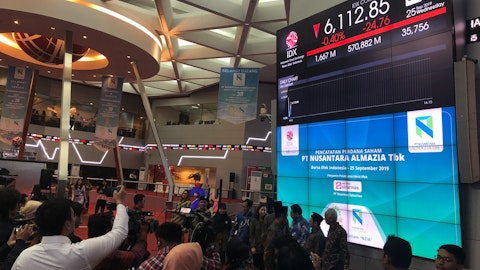In this article, we will take a look at the top 15 most populated cities in South America. If you would like to skip our discussion on the population trends in South America, you can go to the 5 Most Populated Cities in South America.
South America is known for its relatively peaceful status, as it has avoided major armed conflicts since the early 2000s. According to estimates from the United Nations Department of Economic and Social Affairs Population Division, South America’s population crossed 442 million in 2024. It’s expected to grow by around 50 million, reaching 495 million by 2056 before beginning to decline. Among continents, South America ranks second to last in population, with only Oceania having fewer people at 46 million. This makes South America the continent with the second-smallest population, excluding Antarctica, for which, population estimates are unavailable in the UN World Population Prospects Report 2022.
South America has an area of 6,890,000 sq. miles, making it the fourth largest continent in terms of area, following Asia, Africa, and North America. Population-wise, it stands as the fifth most populated continent, trailing behind Asia, Africa, Europe, and North America. South America’s population makes up 5.47% of the total world population. According to the World Bank, the annual population growth rate in Latin America and the Caribbean was recorded at 0.7% in 2022. This rate has been steadily decreasing since 1961, going from 2.8% in 1961 to 2% in 1985 and 1.1% in 2010. South America has just 12 sovereign countries, which is considerably fewer than on other continents. Brazil covers more than half of the region’s area, making it the most populated country in the region.
Over the past three decades, South America has made significant progress in strengthening its economy despite facing challenges like rising inflation, global uncertainty, increasing debt, and low commodity prices. Efforts have also been made to address poverty and unemployment levels, aiming to return them to pre-pandemic levels. The World Bank predicts that the region’s GDP will grow by 2.3% and 2.6% in 2024 and 2025, respectively. Many businesses are acknowledging the benefits of setting up operations in South America and are partnering with local companies. The region has a large and educated workforce and is investing heavily in technology as well. Furthermore, the United States Geological Survey indicates that 54% of global lithium reserves are located in Latin America. The continent holds other important minerals, too, such as copper, cobalt, and nickel. This rich mineral environment in South America makes it an attractive target for international companies seeking to make investments.
Leading Companies Utilizing South America’s Resources
One of the companies taking advantage of minerals across the continent is Vale S.A. (NYSE:VALE), which is one of the largest company and oldest companies in South America. The business has been operational for over seven decades. Vale S.A. (NYSE:VALE) started as an iron ore extraction company but has now expanded into the production and export of copper, iron ore, nickel, coal, and other minerals. In September 2023, Vale S.A.’s (NYSE:VALE) subsidiary, Vale International, entered into a partnership with Essar Group. Vale International is expected to supply the group with around 4 million tons of iron ore agglomerates on a yearly basis.
In addition to Vale S.A. (NYSE:VALE), Ambev S.A. (NYSE:ABEV) is another popular South American company. Ambev S.A. (NYSE:ABEV) was established through the merger of two iconic Brazilian breweries in 1999. Since then, Ambev has experienced growth, particularly during the mid-2010s, followed by a period of stabilization. The company has a diverse portfolio of beers featuring popular brands such as Brahma, Skol, Antarctica, and Quilmes. Ambev S.A. (NYSE:ABEV) holds a dominant position in several countries, with impressive market shares as of 2023, including 68% in Brazil, 96% in Bolivia, 81% in Argentina, 95% in Uruguay, and 90% in Paraguay.
Another innovative company based in South America is WEG SA (BVMF:WEGE3). Established in 1961, this Brazilian company is a global leader in the electrical equipment industry. Over the years, WEG SA (BVMF:WEGE3) has diversified its portfolio to offer a wide range of motors, generators, drives, transformers, and automation technologies. WEG SA experienced revenue growth of 8.69% TTM, increasing from 29.90 billion Brazilian reals to 32.50 billion Brazilian reals, while net income also saw a significant improvement of 36.21% over the last twelve months.

Our Methodology
To shortlist the 15 most populated cities in South America, we referred to data from the United Nations – World Population Prospects Report. The cities have been ranked in ascending order of the latest population estimates by the United Nations.
By the way, Insider Monkey is an investing website that tracks the movements of corporate insiders and hedge funds. By using a consensus approach, we identify the best stock picks of more than 900 hedge funds investing in US stocks. The top 10 consensus stock picks of hedge funds outperformed the S&P 500 Index by more than 140 percentage points over the last 10 years (see the details here). Whether you are a beginner investor or a professional one looking for the best stocks to buy, you can benefit from the wisdom of hedge funds and corporate insiders.
15 Most Populated Cities in South America
15. Cali, Colombia
Population: 2.89 million
Cali is a city in western Colombia situated on both sides of the Cali River. It was founded in the 1500s but did not rise to prominence until the 1950s. It is Colombia’s third-largest city, after Bogotá and Medellín. Cali is a major collection and distribution center for agricultural products. It is also a strategic Colombian transportation center that links major cities by railroad and highway. The city also has an international airport and a military air base.
14. Caracas, Venezuela
Population: 2.99 million
Caracas is the capital of Venezuela and one of the principal cities of South America. It is Venezuela’s largest urban center and the country’s main hub for industry, commerce, education, and culture. The city expanded rapidly after the 1940s. Apart from the national capital, it is also the seat of the Capital District, which is spread across 167 square miles. The city has expanded beyond these boundaries into the state of Miranda.
13. Guayaquil, Ecuador
Population: 3.19 million
Guayaquil is Ecuador’s main port. It is on the west bank of the Guayas River, 45 miles from the Gulf of Guayaquil, off the Pacific Ocean. The city is low-lying and has a hot and humid climate. It was widely considered a plague spot, but since 1920, the government has focused on engineering and hygiene, which has greatly reduced health hazards. The city has sugar refineries, iron foundries, tanneries, and sawmills, as well as a fabricating and processing center for multiple light consumer goods. Shrimp farming is also a major industry in the city.
12. Curitiba, Brazil
Population: 3.85 million
Curitiba is situated in southern Brazil. The city has roots as a gold mining, tea, and wood processing center. It has many immigrants from international and rural areas. Curitiba underwent extensive revitalization efforts, including the development of water bodies, parks, and recreational spaces in the 1970s.
11. Salvador, Brazil
Population: 3.99 million
Salvador is a major port city and State capital of Bahia state in northeastern Brazil. It is Brazil’s third-largest city. It is located at the southern tip of a peninsula that separates Todos os Santos (All Saints) Bay, a natural harbor, from the Atlantic Ocean.
10. Medellin, Columbia
Population: 4.14 million
Medellín is the capital city of Antioquia in northwestern Colombia. It lies along the Porce River at an elevation of 5,000 feet above sea level. It is one of Columbia’s largest cities and is heavily industrialized, with a focus on the steel and coffee industry. The city has a varied industrial base that includes food processing, woodworking, metallurgy, automobiles, chemicals, and rubber products.
9. Fortaleza, Brazil
Population: 4.25 million
Fortaleza is a port city and state capital of Ceará in Northeast Brazil. Positioned at the mouth of the Pajeú River, it originated as a small village and has turned into a modern urban center. The port’s trade items include sugar, cashews, salt, cotton, wax, hides, textiles, and clothing. Industries in the area manufacture dyes, electroceramics, and Styrofoam packing materials. Fortaleza is well-connected to surrounding cities via a road network, while its railway links the city and its port with agricultural regions to the southwest. Fortaleza is among the top 10 most populated cities in South America.
8. Brasilia, Brazil
Population: 4.94 million
Brasília, the federal capital city of Brazil, is situated within the Federal District in the state of Goiás. The city is positioned at an elevation of 3,500 feet and lies between the Tocantins, Paraná, and São Francisco rivers. Due to its unique city plan and architecture, as well as its role in the development of the Brazilian interior, the city was designated a UNESCO World Heritage site in 1987.
7. Belo Horizonte, Brazil
Population: 6.3 million
Belo Horizonte is a mountain city in southeastern Brazil. It is on the western slope of the Espinhaço Mountains, at a height of 2,720 feet. The city was planned out on a grid pattern based on the theme of Washington, D.C., in the United States and La Plata in Argentina. With a population of 6.3 million, Belo Horizonte is one of the most populated cities in South America.
6. Santiago, Chile
Population: 6.95 million
Santiago, the capital of Chile, is situated along the canalized Mapocho River. The city serves as a hub for Chile’s industrial activity, with a focus on food items, textiles, shoes, and clothing production. The city has an active financial sector featuring a stock exchange, numerous large banks with extensive branch networks, and many insurance companies. A comprehensive road network connects the city with the ports of San Antonio to the west and Valparaíso to the northwest.
Click to continue reading and see the 5 Most Populated Cities in South America.
Suggested Articles:
- Jim Cramer is Recommending These 10 Stocks in April
- 10 Best Low Volatility ETFs To Buy
- 10 Micro-Cap Healthcare Stocks Insiders Are Buying
Disclosure: None. 15 Most Populated Cities in South America is originally published on Insider Monkey.





